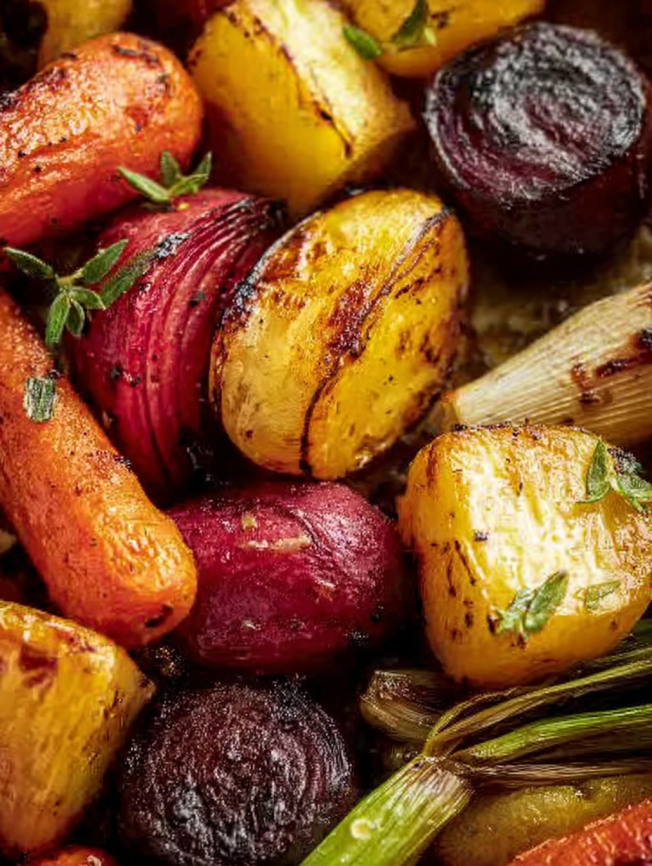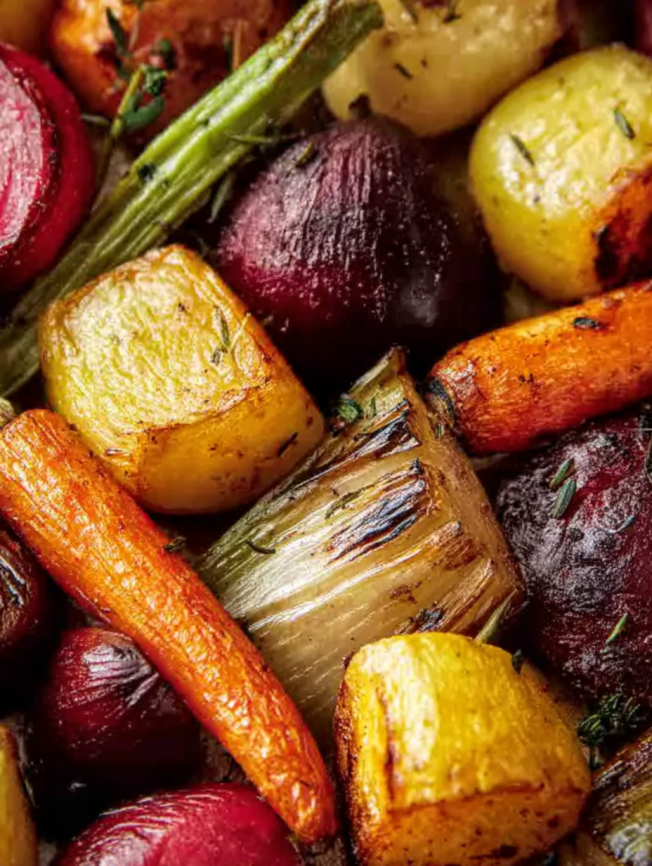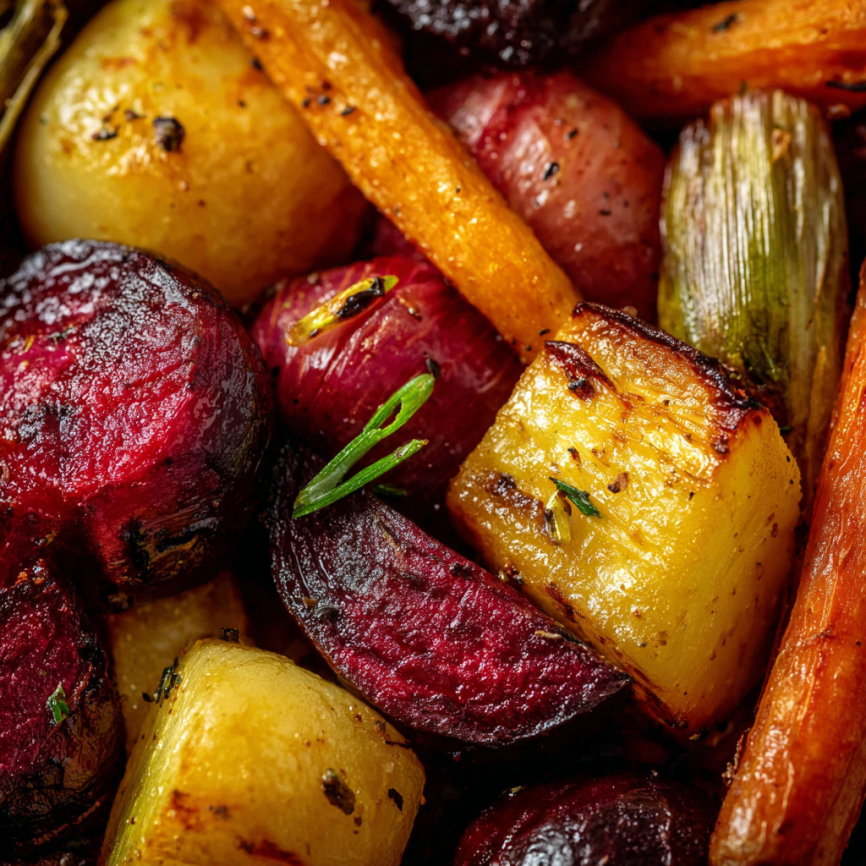Every year when spring arrives, I find myself drawn to the vibrant produce displays at the farmer’s market. There’s something magical about those first tender asparagus spears, glossy baby carrots, and colorful radishes that signals winter’s end. After months of hearty root vegetables and preserved foods, my kitchen craves the fresh, bright flavors that only spring can deliver. That’s exactly how this roasted spring vegetable recipe was born – from a desire to capture all that seasonal beauty on one simple, stunning platter.
Why This Spring Vegetable Medley Will Become Your New Favorite
This roasted spring vegetable dish represents everything wonderful about seasonal cooking. First, it showcases the natural beauty and flavor of fresh spring produce when it’s at its absolute peak. Additionally, roasting transforms these tender vegetables into something truly spectacular, caramelizing their edges while maintaining that perfect tender-crisp texture inside.
Furthermore, this recipe offers incredible versatility – serve it as an elegant side dish for Easter dinner, incorporate it into meal prep containers for the week, or enjoy it as a light, healthy main course with some crusty bread. The preparation couldn’t be simpler, yet the results look professionally crafted and taste absolutely divine.
Most importantly, this dish celebrates seasonal eating at its finest. By choosing vegetables that are naturally abundant in spring, you’re not only getting the best flavors and textures, but also supporting sustainable farming practices and getting maximum nutritional value from your food.
The Magic of Roasting Spring Vegetables
Roasting vegetables isn’t just a cooking method – it’s a transformation technique that elevates simple produce into something extraordinary. When spring vegetables meet high heat in the oven, several wonderful things happen simultaneously. The natural sugars in the vegetables begin to caramelize, creating those beautiful golden-brown edges that add both visual appeal and concentrated sweetness.
Meanwhile, the high temperature helps vegetables retain their vibrant colors while developing complex, nutty flavors that you simply can’t achieve through steaming or boiling. Each vegetable maintains its unique character while harmonizing perfectly with its companions on the roasting tray.
Why Spring Vegetables Are Perfect for Roasting
Spring vegetables possess unique qualities that make them ideal candidates for roasting. Unlike their winter counterparts, spring vegetables are naturally tender and require shorter cooking times. Baby carrots, young potatoes, and fresh asparagus have thinner skins and more delicate flesh that roasts beautifully without becoming tough or woody.
Moreover, spring vegetables offer a natural color palette that creates stunning visual appeal. The deep orange of baby carrots, vibrant green of asparagus, purple-tinged radishes, and golden baby potatoes create a rainbow effect that makes any meal feel special and festive.
The Health Benefits of Seasonal Eating
Choosing seasonal produce like these spring vegetables offers numerous health advantages beyond just superior taste. Spring vegetables are typically harvested at peak ripeness, meaning they contain higher concentrations of vitamins, minerals, and antioxidants compared to out-of-season alternatives that may have traveled long distances or been stored for extended periods.
Additionally, eating seasonally naturally varies your diet throughout the year, ensuring you receive a diverse range of nutrients. Spring vegetables are particularly rich in vitamin C, folate, and fiber – exactly what your body needs as it transitions from winter’s heavier foods to summer’s lighter fare.
Essential Ingredients for Success
Fresh Spring Vegetables:
- 1 cup baby potatoes, halved
- 1 cup baby carrots, peeled
- 1 cup radishes, halved
- 1 cup asparagus, trimmed and cut into 2-inch pieces
- 1 cup green beans, trimmed
Flavor Enhancers:
- 2 tablespoons high-quality olive oil
- 1 tablespoon balsamic vinegar
- 2 cloves garlic, minced
- 1 teaspoon dried thyme
- 1 teaspoon dried oregano
- Salt and freshly ground black pepper, to taste
- Fresh parsley, chopped (for garnish)
Perfect Pairings:
These roasted vegetables complement grilled chicken, salmon, or lamb beautifully. They also work wonderfully alongside quinoa or farro for a complete vegetarian meal, or tossed with pasta and a light cream sauce for a spring-inspired dinner.
Step-by-Step Roasting Instructions
Initial Preparation
Start by preheating your oven to 400°F (200°C), which provides the ideal temperature for caramelizing vegetables without burning them. This moderate-high heat ensures even cooking while developing those coveted golden-brown edges that make roasted vegetables so appealing.
Vegetable Preparation
Wash all vegetables thoroughly under cold running water. Next, prepare each vegetable according to its needs: halve the baby potatoes to ensure even cooking, peel the baby carrots if desired (though young carrots often don’t require peeling), and trim the asparagus by snapping off the tough ends where they naturally break.
Creating the Perfect Coating
In a large mixing bowl, combine all the prepared vegetables. Drizzle with olive oil and balsamic vinegar, then add the minced garlic, dried thyme, oregano, salt, and pepper. Using your hands or a large spoon, toss everything together until each piece is evenly coated with the oil and seasonings.
Arranging for Optimal Roasting
Spread the seasoned vegetables in a single layer on a large baking sheet, ensuring they don’t overlap. Overcrowding leads to steaming rather than roasting, which prevents that desirable caramelization. If necessary, use two baking sheets to give your vegetables adequate space.
The Roasting Process
Place the baking sheet in the preheated oven and roast for 25-30 minutes. Halfway through the cooking time, use a spatula to flip the vegetables, ensuring even browning on all sides. The vegetables are done when they’re tender when pierced with a fork and have developed golden-brown edges.

Creative Serving Suggestions
As a Stunning Side Dish
Transfer the hot roasted vegetables to a beautiful serving platter and sprinkle generously with freshly chopped parsley. The bright green herbs add a final pop of color and fresh flavor that perfectly complements the caramelized vegetables.
Meal Prep Magic
These roasted vegetables are excellent for meal preparation. Divide them among glass containers and refrigerate for up to 4 days. They’re delicious cold in salads, reheated as a side dish, or incorporated into grain bowls throughout the week.
Creative Main Course Ideas
Transform these vegetables into a complete meal by serving them over creamy polenta, tossing with cooked pasta and parmesan cheese, or arranging over mixed greens with a light vinaigrette for a substantial salad.
Delicious Recipe Variations
Mediterranean Twist
Replace the thyme and oregano with fresh rosemary and add sliced red onions to the vegetable mix. Finish with crumbled feta cheese and a squeeze of fresh lemon juice for a Greek-inspired variation that’s absolutely divine.
Asian-Inspired Version
Substitute sesame oil for half the olive oil and add fresh ginger to the garlic. Finish with a drizzle of soy sauce and a sprinkle of sesame seeds for an entirely different flavor profile that’s equally delicious.
Herb-Forward Variation
Use fresh herbs instead of dried ones – try fresh thyme, oregano, and rosemary. Add them during the last 10 minutes of roasting to prevent burning while still infusing the vegetables with their aromatic oils.
Make-Ahead Tips for Busy Schedules
Advance Preparation
You can prepare all the vegetables up to 6 hours ahead of time. After washing and cutting, store them in the refrigerator in separate containers or together in a large bowl covered with plastic wrap. However, don’t add the oil and seasonings until just before roasting to maintain optimal texture.
Partial Cooking Method
For even more convenience, you can partially roast the vegetables earlier in the day. Cook them for about 15 minutes, then cool completely and refrigerate. When ready to serve, return them to a hot oven for the final 10-15 minutes until heated through and golden.
Freezing Guidelines
While these vegetables are best enjoyed fresh, you can freeze the cooked dish for up to 3 months. Cool completely before transferring to freezer-safe containers. Thaw overnight in the refrigerator and reheat in a 375°F oven until warmed through.
Pro Tips for Perfect Results
The key to achieving restaurant-quality roasted vegetables lies in attention to a few crucial details. First, ensure all vegetables are cut to similar sizes so they cook evenly. Baby potatoes may need to be quartered if they’re particularly large, while very thin asparagus spears might need less cooking time.
Don’t skimp on the oil – vegetables need adequate fat to caramelize properly. However, too much oil will make them soggy, so aim for just enough to lightly coat each piece. Fresh garlic burns easily at high temperatures, so if you prefer a stronger garlic flavor, add it halfway through the cooking process.
Nutritional Benefits Worth Celebrating
This colorful medley provides an impressive array of nutrients in every serving. Asparagus offers folate and vitamin K, while carrots contribute beta-carotene and fiber. Radishes provide vitamin C and antioxidants, and baby potatoes offer potassium and vitamin B6. Together, these vegetables create a nutritionally balanced side dish that supports overall health while satisfying your taste buds.

Frequently Asked Questions
Can I use frozen vegetables instead of fresh? While fresh vegetables provide the best texture and flavor, you can use frozen vegetables in a pinch. Thaw them completely and pat dry before seasoning and roasting. Keep in mind that they may require slightly less cooking time and won’t achieve the same level of caramelization.
What if some vegetables cook faster than others? This is normal! Asparagus and green beans typically cook faster than potatoes and carrots. You can add the quicker-cooking vegetables halfway through the roasting time, or cut the denser vegetables smaller to ensure even cooking.
How do I know when the vegetables are perfectly done? The vegetables should be tender when pierced with a fork but still hold their shape. They should have golden-brown edges and look caramelized. If they’re browning too quickly, lower the oven temperature to 375°F and continue cooking.
Can I prepare this recipe on the grill instead? Absolutely! Use a grill basket or create foil packets with the seasoned vegetables. Cook over medium-high heat for 20-25 minutes, shaking the basket or turning the packets occasionally for even cooking.
What’s the best way to store leftovers? Store leftover roasted vegetables in the refrigerator for up to 4 days in an airtight container. They’re delicious cold in salads or can be reheated in a 350°F oven for 10-12 minutes until warmed through.
Can I add other vegetables to this mix? Certainly! Other excellent spring additions include baby zucchini, snap peas, or baby turnips. Just ensure all vegetables have similar cooking times, or add quicker-cooking ones partway through the roasting process.
Prep Time: 10 minutes
Cooking Time: 30 minutes
Total Time: 40 minutes
Calories: 180 kcal per serving
Servings: 4

